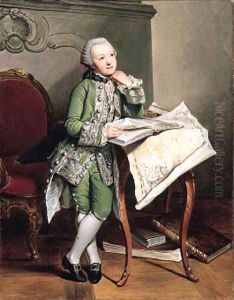Georg David Matthieu Paintings
Georg David Matthieu was a notable portrait painter active during the 18th century, particularly known for his contributions to the German and Baltic art scenes. Born on September 28, 1737, in Berlin, Matthieu was deeply influenced by the artistic environment of his time, which was characterized by the flourishing of Rococo style, characterized by its ornate and decorative qualities.
Matthieu's early life was marked by his immersion in the world of art, a path likely influenced by the cultural milieu of his birthplace. He showed an early aptitude for painting, which led to his formal training in the arts. His education and talent propelled him to the attention of notable patrons, who were instrumental in the development of his career.
Throughout his career, Georg David Matthieu became especially renowned for his skill in capturing the likeness and character of his subjects. His portraits are celebrated for their intricate detail, vibrant colors, and the ability to convey the personality and status of the sitters. Matthieu's works often depicted members of the nobility and prominent figures of the time, serving as a valuable documentation of the era's social and cultural elite.
In addition to his portraiture, Matthieu's contributions to the arts included his role as a court painter, a prestigious position that allowed him to work closely with the aristocracy and royalty. This role not only elevated his status as an artist but also provided him with a steady stream of commissions, ensuring his financial stability and artistic freedom.
Despite his success, Matthieu's life was relatively short; he died on October 3, 1778, in Ludwigslust, at the age of 41. His death marked the loss of a significant figure in the world of 18th-century portrait painting. However, his legacy continues to be appreciated by art historians and enthusiasts alike, who celebrate his contributions to the development of portrait art. Matthieu's works remain exhibited in various art galleries and museums, where they continue to be admired for their beauty and historical significance.












